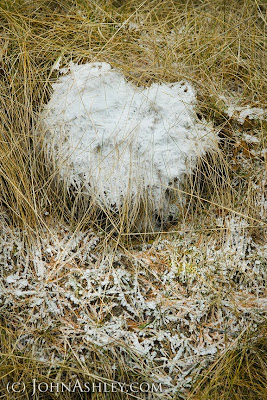 |
| Hoar-frost ice crystal growing on a grass stem |
Going back in time, "hoar" grew out of the Middle English, "hore," which came from the Old English, "hār," itself originating from the Proto-Germanic, "hairaz." It is cognate, or related to Old Norse "hārr," Old High German, "hēr," and Old Slavonic, "sěrǔ." The first known use of "hoar" was in 1567, while its roots grew down into the 11th century.
 |
| Thick hoar-frost covers opening to squirrel den |
The root words for hoar led from venerable to grey-haired, morphing into a term that tethers the vision of white ice crystals to that of an old man's beard. The root words for frost led from a generic, "to freeze," to the slightly more specific, "turn to ice."
These days, our winter walks through the woods and over to the frozen creek lead here and there through patches of what one might call, "hore-forst." As we move on through November and the temperature keeps dipping, frost will eventually form on my hoary beard, freezing lips and cheeks until my own English starts sounding rather old.

